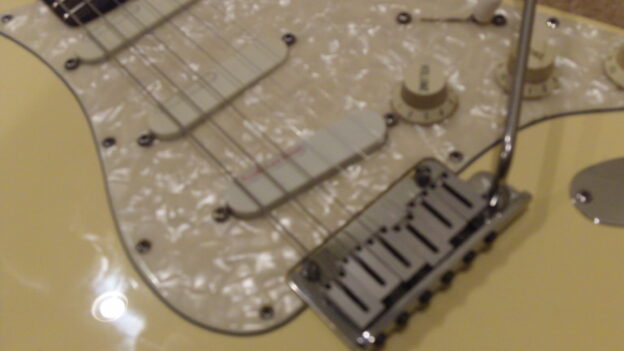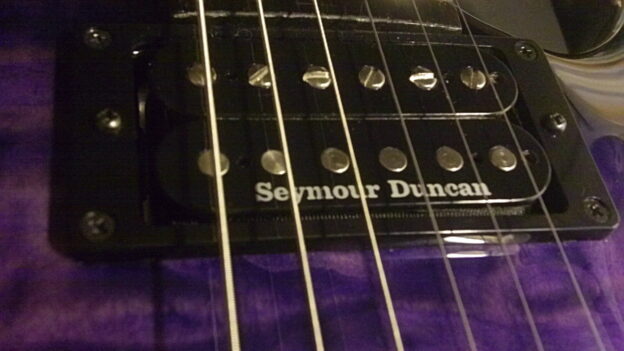By Chad Crawford, PMI Guitar Instructor
As guitar players we usually have two general goals: (1) self-expression and (2) learning our favorite songs. While there is some overlap between the skill sets for these two goals, learning others’ songs is often the easier of the two, and it can help us keep our motivation strong while we are working on the loftier goal of self-expression. In this article we will break down the process of learning songs.
First, do not go straight to a free TAB site. Instead, try the procedure below FIRST. We will come back to transcriptions in a moment.
Step 1. Listen to the song! This statement may seem frivolous since you have probably already listened to your favorite songs many times. However, listening to learn is different than listening for enjoyment. When you are listening to learn, you must focus your attention fully on the song and all the parts of the song. For instance, listen for the chord changes and for how long each chord lasts. Listen for differences in chord arrangement between verse, chorus, and bridge. Listen to the vocal structure. Vocal structure is often more obvious and easier to remember than chord changes, and so the vocal cues will help you remember when the chord changes are coming. Listen carefully for prominent guitar fills, and of course pay attention to where the solo (if any) falls within the song structure, i.e. verse, chorus, verse, chorus, solo.
This is not the kind of listening you typically do where the music is in the background while your mind is wandering elsewhere. You must focus your full attention on the song and keep it there throughout the song, making mental note of important events such as chord changes and fills. I recommend to use headphones and close your eyes while listening to the song at least a few times, but the more times the better.
Step 2. Try to figure out the key of the song. You can do this by continually picking the sixth string as you move your fretting finger up the fretboard until you hear that your note matches the fundamental reference pitch of the song, which is usually the first chord of the song. Listen not only to the guitar(s) but also the bass in helping you determine the key.
Step 3. Determine whether the mood of the song is major or minor. This does not have to involve any kind of complicated music theory analysis. Just listen for the overall feel of the song. Does it sound bright, happy, and upbeat? Then it is probably major. Does it sound more melancholy, serious, and dark? Then it is probably minor. Much country music is in a major key, while much rock music is in a minor key. While there are other possibilities than strictly major or minor (such as the Dominant progressions of Blues which fall between major and minor), a large percentage of popular music falls into one of these two moods. Listening for the mood of the song will help you narrow down the possibilities for chords and scales.
Step 4. Sort out the chord changes. For most popular music, once you know whether the song is major or minor then there are only a handful of likely basic chords. Once you figure out the basic chord possibilities, then it is not very much more work to determine what alterations if any the artist has made to the basic chords. It is helpful to consider that most popular songs will contain the 1st, 4th, and 5th interval chords from the key, and the 6th is also a popular chord. Keep these chord progressions in mind since you will probably find that your favorite song is going to contain something along the lines of these common progressions: I-IV-V-I, I-IV-I-V, I-V-vi-IV. If it is a rock song with heavy distortion the chords will often be 5th chords (power chords), whereas if it is a cleaner guitar tone then the chords will often be more along the lines of the typical major or minor open or bar chords that you know.
Listen carefully to the song. It is going to start on some chord which will match the key and mood of the song. Then it will do one of two things, go up or go down in pitch to the next chord. So experiment until you figure out that chord. For instance, if the opening chord is a G major, the next chord will likely go up in pitch, and is likely to be a similar type of chord. In other words, if the opening chord is a G Major, the next chord is not going to be a Bb7b5 or some other monstrous mysterious chord. Rather it is probably going to be a simple C or D Major. So plug in the chords you know and see what fits. Repeat until you have figured out the chords.
Step 5. If there is a solo in the song, listen to it repeatedly as before. Now consider the mood of the song: major or minor? If it is major, the solos will likely contain some variation of the Major Pentatonic scale. If minor, then the Minor Pentatonic is a likely option. From there, listen again and see if you do not hear bits of the scale you think is probably the right one. Pick out the parts of the solo that you can quickly figure out.
Now it gets a little tricky, because solos are often fast moving, usually do not follow strict scale patterns, and often include licks from scales other than the basic pentatonic scales. So this is where you need to bring in the “heavy guns”.
(a) Use a transcription software such as Transcribe to slow down the solo so that you can hear clearly how the notes are moving from one to the next, then pick them apart one by one until you have a particular lick worked out. Then move to the next lick and repeat and until you have the solo figured out. Many of these software programs will allow you to “loop” a small segment of a song. In other words, you can select beginning and end points within the song and the software will play that little segment over and over in a loop for you while you listen and figure out the notes.
(b) Get help from your teacher
(c) After trying all this, THEN go get a real professionally scored TAB if possible (some popular songs do not have pro TABs available). This should be the LAST step you take after having tried the ones above. At first, you will not get far with deciphering the songs, but the more you do it, the better you get. So try to do it yourself first, then when you reach the end of your transcribing skills, go get a TAB. I recommend to avoid free TAB web sites since the TAB is user generated (any beginner can submit a self-written TAB) and I have found that these TABS are often completely wrong. You can find good professionally scored TABS at Musicnotes.com and FreehandMusic.com. Even with pro TAB, you will need to listen to the song carefully to make sure what you are playing matches the song. Some aspects of guitar technique are nearly impossible to convey on paper, and even the pros make an occasional mistake.
Bear in mind, this will be challenging at first. Don’t give up! These procedures work well with common popular songs, but they will be much more challenging for certain genres such as fusion, jazz, or progressive rock. For transcribing in these more complex styles, you will need a more expansive mastery of music theory and a well developed ear. Start with simple songs that have clear chord changes and relatively simple solos at slow moderate speeds, such as Blues standards or iconic classics like Pink Floyd’s Comfortably Numb.
Be tenacious. Happy Transcribing!
Copyright © 2005 Palmetto Music Institute. All Rights Reserved.


